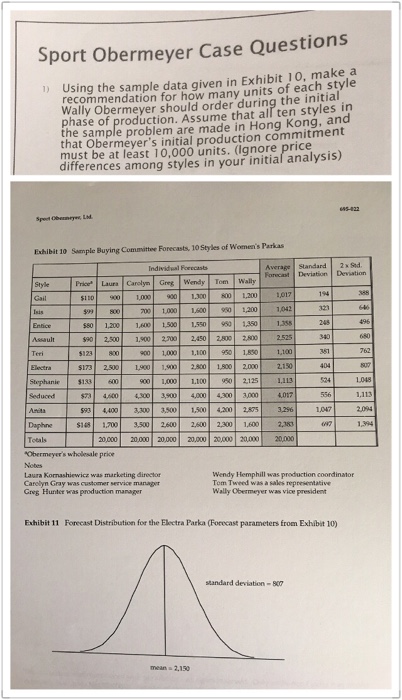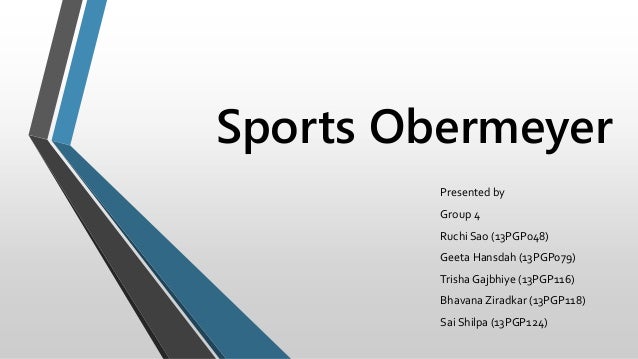Sports Obermeyer Case Study
Sports Obermeyer.Sport Obermeyer, Ltd. Business Case Report Sport Obermeyer, Ltd. Business Case Report Table of Contents Executive Summary 1 Issue Identification 2 Environmental and Root Cause Analysis 3 Alternatives & Options 4 Recommendations 5 Implementation 6 Monitor and Control 7 Sport Obermeyer, Ltd. Business Case Report Executive Summary Each year we are challenged with matching.


Case Study 1 Instructions. Read the Sport Obermeyer Case Study in the Simchi-Levi et al. Submit a response to each of the end-of-case discussion questions. Each question must be answered thoroughly, and responses must be supported by the concepts introduced in the reading/study materials. SPORT OBERMEYER CASE ANALYSIS 3 Sport Obermeyer Case Analysis Sport Obermeyer is a skiwear design and merchandising company based in Aspen Colorado. Wally Obermeyer is the son of the founder and CEO and currently serves as Vice President. Sport Obermeyer is currently planning production and sourcing for its new season of items to sell.
Obermeyer Sport A Strategic Direction in Forecasting Introduction & Summary Klaus Obermeyer is an innovator in the high-end skiwear industry. The company began with down filled jackets and slowly began to diversify its product line with high-altitude suntan lotion, turtlenecks, nylon wind-shirts, mirrored sunglasses and more. In 1961, the first Sport Obermeyer factory warehouse opened in Aspen, and the innovations continued with “soft-shell” jackets, double lens goggles, and the first waterproof-breathable fabrics to be used in clothing.
Sport Obermeyer is a high-end fashion skiwear design and merchandising company with its headquarters located in Aspen, Colorado. The company specializes in selling its products in U. S. department stores and ski shops. Although the company has a global supply network, most of its outerwear products are channeled through Obersport. [1] In the fashion skiwear industry - demand is very dependent on several factors that are difficult to predict. The inconsistent nature of the economy, fashion trends and weather create a significant challenge for a firm such as Sport Obermeyer.
By actively applying a selection of appropriate forecasting methods and continuing to adapt to this fast-paced industry, Obersport would be able to remain competitive and retain or increase its 1992 high market share entering into the 1993/94 season. Analysis A joint venture was established between Klaus Obermeyer and Raymond Tse in 1985. This company gained the title of Obersport Ltd. This joint venture allowed Obermeyer to manage supply and production operations in Hong Kong and China. [2] Until the mid-1980s, Obermeyer followed a simple design-and-sales cycle: The first stage was to design the product, then fabricate and showcase samples to retailers in March usually at fairs/shows ? The second stage was to place production orders with suppliers in March and April after receiving retail orders from the fairs/shows. ? The third stage was to receive goods at Sport Obermeyer’s distribution center in September and October; and ship product immediately to retail outlets. During the mid-1980s, several factors rendered this approach obsolete: ? As sales volume grew, the company hit manufacturing ceilings during the peak ski wear-production period. Being unable to order sufficient quantities during critical summer months reduced the supply for ongoing demanded volume, to be produced after it has received retail orders. Therefore, the company begins booking production the previous November, or about a year before goods would be sold, based on speculation about what retailers would order. Processes and Strategies A ski jacket being distributed in the U. S. could be asembled in China from fabrics and findings (zippers, snaps, buckles, and thread) sourced from Japan, South Korea, and Germany.
Haven’t found the relevant content? Hire a subject expert to help you with Sport Obermeyer Case
Hire verified expertThis global supply chain (Exhibit 1. 0) created more product variety and improved production efficiency, but at the same time greatly increased lead times. Reaction to the lengthening supply chains, limited supplier capacity, and retailers’ demands for earlier delivery were all prominent obstacles. Obersport began developing a variety of quick-response initiatives such as to shorten lead times to overcome them. First introduced were computerized systems to slash time in processing orders and computing raw-material requirements.
This technology would anticipate what raw materials it would require and pre-position them in warehouses in the Far East because lead time for obtaining raw materials proved difficult to shorten. To shorten this time Obersport used air freight for delivery from the Far East to the Denver distribution centre as delivery due dates quickly approached. In the 1990s, these changes had reduced delivery times by more than one month. [3] Along with these changes, the Sport Obermeyer applied some other tactics in the 1990s.
Obermeyer persuaded some of its important retail customers to place their orders sooner, providing the company with valuable foreword information such as the popularity of certain styles. Invited were 25 of the company’s largest retailer customers to Aspen each February offering them a preview of the new annual line and solicit early orders. This was called an “Early Write” which accounted for about 20 percent of the total sales. About half of production requests depended highly on demand forecasts still. An in-house buying committee approach was allocated to generate these forecasts. 4] Short life cycle Issues There are three topics in today’s business environment that are especially relevant to this case: ? Production planning for short-life-cycle fashion products ? Operational changes that reduce the cost of mismatched supply and demand ? Coordination issues in a global supply chain. The Bullwhip Effect (or Whiplash Effect) is an observed phenomenon in forecast-driven distribution channels. Since the oscillating demand magnification upstream a supply chain reminds someone of a cracking whip it became famous as the Bullwhip Effect.
For seasonal goods such as winter sportswear, which has a short selling season and long lead times, a firm can do several things to better match supply and demand: • Additional events can be held before large trade fairs in order to secure orders further in advance. • Supplier capacity can be reserved without specifying the exact product mix. This postponement of the final mix has benefits similar to those of postponing product customization until the distribution center. • Common parts can be used in designs in order to pool some of the variation between individual demands. [5] Demand Forecasting
The different types of forecasting include: • Economic forecasts address the business cycle. Ie inflation rate, money supply, and housing starts • Technological forecasts predict the rate of technology progress and impact the development of new products • Demand Forecasts predicts sales of existing products and services. This is the type of forecasting relevant to the Obermeyer case. [6] The Importance of Forecasting [pic] Forecasts are based on statistics, and they are rarely perfectly accurate. Because forecast errors are a given, companies often carry an inventory buffer called 'safety stock'.
Moving up the supply chain from end-consumer to raw materials supplier, each supply chain participant has greater observed variation in demand and thus greater need for safety stock. In periods of rising demand, down-stream participants increase orders. In periods of falling demand, orders fall or stop to reduce inventory. The effect is that variations are amplified as one moves upstream in the supply chain (further from the customer). The causes can further be divided into behavioral and operational causes: Behavioral causes to forecasting Misuse of base-stock policies • Misperceptions of feedback and time delays • Panic ordering reactions after unmet demand • Perceived risk of other players' bounded rationality Operational causes • Dependent demand processing • Forecast Errors • Adjustment of inventory control parameters with each demand observation • Lead Time Variability (forecast error during replenishment lead time) • Lot-sizing/order synchronization • Consolidation of demands • Transaction motive • Quantity discount • Trade promotion and forward buying Anticipation of shortages • allocation rule of suppliers • shortage gaming • Lean and JIT style management of inventories and a chase production strategy The information above (Importance of Forecasting) was provided by Wikipedia: http://en. wikipedia. org/wiki/Bullwhip_effect Objectives Despite current forecasting strategies being used at Sport Obermeyer to satisfy the constantly changing consumer demands, goals and targets must be set in order to improve weak areas allowing the company to remain competitive for the upcoming season.
The following objectives are used to further develop the company’s forecasting strategies for the 1993/94 season. 1. Find new ways to accurately estimate the quantity of each style required in the initial phase of production. 2. Implement operational changes that will improve overall performance. 3. Properly align current supply chain sources subject to supply channels in Hong Kong and Greater China. Recommendations The following recommendations have been created to ensure the company meets its required objectives. 1.
Wally Obermeyer reflects the results from the buying committee meeting that is held in November, annually. This year Wally strayed away from the usual system of having six key managers make production commitments based on the group’s consensus, to having each member give a personal forecast retailer demand for each of the products sold at Sport Obermeyer. We recommend that he takes each manager’s forecasts and makes one forecast based on the other manager’s predictions. A good formula to use in order to accomplish this is ? i-k? i= 10,000 units. (refer to exhibit 3. 0)This formula takes both the mean of all of the other manager’s forecasts and the distribution of everyone’s forecast into consideration. By improving the internal forecasts by applying this forecasting model with the data used from past sales instead of a simple average made by the buying committee. [7] 2. The main operational changes that Wally should focus on in order to increase productivity is to initially focus on splitting the seasonal orders into two lots:
Speculative Order The first lot should be an order of 10,000 units placed approximately 10 months before the selling season. This order will be made through China, considering that they are less expensive and need more time for production. This order will consist of the quantities produced from the data attained through a weighted average method as identified above. Reactive Order The second lot should be ordered closer to the selling season, approximately six months, and should also be 10,000 units.
The quantities in this order should be decided based on which items are popular in the Las Vegas fashion show. The Vegas fashion show should offer a better prediction of popular trends in the season. This order should be produced by Hong Kong manufacturers considering that they are faster, more efficient and more flexible. Although, it would be much less expensive to order through China, given the short time line for this second order it is essential to use Hong Kong. [8] 3. Due to lower costs, but longer lead times, Sport Obermeyer should make a majority of its speculative order to China.
With strict quota restrictions limiting the number of units that can be imported from China into the United States, it is necessary to ensure the orders brought into the US before the quota has hit a maximum. Sport Obermeyer forecasts an annual demand for its product and as a result supply channel partners need to undergo change to develop and deliver new product lines annually. Therefore, Obermeyer retroactive order should be manufactured in Hong Kong to avoid the risk of declined imports (Exhibit 2. 0). The Hong Kong manufacturer also provides higher quality and quicker production times, but at a higher price.
Conclusion [pic] Obermeyer did employ all of the recommended strategies (to some degree) to satisfy the three outlined objectives entering into the 1993/94 season. Although Obermeyer did increase their quality control functions to position themselves as one of the highest quality brands in the market, they continued to use essentially the same supply chain. The company has since evolved from its operations in the early 1990’s to investing highly in research and development as this is the only way to remain competitive as a premium brand supplier in the 21st century.
Sport Obermeyer now follows the following strategy: “Obermeyer Product Technology defines our commitment to the demand of function and performance. Today, more than ever, we are designing garments that are pushing the boundaries of outerwear technologies. Introducing new systems of integrated synergistic components which create exceptional, high-performance winter gear: The Advanced Technology Series is way of the future. ” Despite their fundamental changes in corporate strategy, effective operations management remains a critical part of the ongoing success of Sport Obermeyer Ltd.
Sport Obermeyer Case Study
Exhibits Exhibit 1. 0 – Supply Chain [pic] Exhibit 2. 0 - Comparative Analysis |Hong Kong |Greater China | |Advantages |Disadvantages |Advantages |Disadvantages | |Workers 50% faster than Chinese |Shorter hours worked, less |Significantly lower wage/hour |Workers not as efficient | |counterparts |overtime allowance |(US$0. 6/hr) |Narrower range of tasks | |Higher weekly output/worker |Higher labour costs |Ample supply of manufacturing |Long production lines | |Trained in broader range of |Shortage of younger workers |human resources |Much higher minimum order | |tasks |Insufficient number of workers |Lower landed cost |quantity for same style | |Lower minimum order quantity for|Higher landed costs | |Slow repair rate (10%) | |same style | | | | |Fast repair rate (1-2%) | | | | Exhibit 3. 0 – Speculative Production Quantities Assumptions ? All ten styles are made in Hong Kong, and Obermeyer's initial production commitment is at least 10,000 units. Different unit costs of production are inapplicable |Style |Average Forecast (µ)|Standard |2x Standard Deviation |Product Quantity | | | |Deviation |(? i) | | | | | |Isis |357. 24 | |Entice |832. 24 | |Assault |1804. 2 | |Teri |292. 28 | |Electra |1293. 52 | |Stephanie |2. 12 | |Seduced |2838. 28 | |Anita |1076. 36 | Daphne |905. 36 | Exhibit 4. 0- Product Life Cycle [pic][9] Project Management Group Three: Craig Brown, Evan Farquhar , Jay Maynard, Sarah-May Kilpatrick, Sean Vrooman The first step taken was to appoint a Project Manager for our group. We decided to appoint Sean Vrooman due to his background in Human Resources and having a strong understanding of Project Management. The first thing put into place was we created a plan for how we would structure this assignment. First we analyzed what the objectives were and how we could meet them over a timeline. We then devolved a work break-down schedule to split up certain tasks to individuals in the group.

Sport Obermeyer Case Analysis
Our first meeting was Tuesday November 3rd, 2009. We decided to meet every Tuesday but with limited resources we decided to start meeting twice a week for the last three weeks to help us move at a faster pace through the project. In total we met seven times with emails back and forth discussing and analyzing each other’s work. After implementing a schedule based on our working methods we had a very strong and competent order of who was doing what part of the paper and how we were going to present our material to the class. No methods were required In genereal this group functioned very well together. Everyone contributed in a very equal and professional manor.
We completed this project on time and did not need the assistance of any extra materials like Gannt charts or critical paths. ----------------------- [1] Janice H. Hammond, Ananth Raman, Harvard Business School, Sport Obermeyer, Ltd. [2] Janice H. Hammond, Ananth Raman, Harvard Business School, Sport Obermeyer, Ltd. [3] www. personal. umd. umich. edu/~drossin/class/gommo4 [4] courses. washington. edu/smartman/Ass3. htm [5] http://www. quickmba. com/ops/scm/ [6] Heizer_9_ch4 [7] [pic]678GOP’? E? •±- = O f o iU? §–…tcRcRcRcAcAc! h€Uhz?? B*OJQJaJphy! h€UhI? www2. isye. gatech. edu/~jvandeva/Classes/6203/... /12Obermeyer. ppt [8] www. utdallas. edu/~metin/Or6366/Folios/scnewproduct. ppt [9] Heizer_9_ch4
Haven’t found the relevant content? Hire a subject expert to help you with Sport Obermeyer Case
Sports Obermeyer Case Solution
 Hire verified expert
Hire verified expertSport Obermeyer Ltd

Cite this page
Sport Obermeyer Case. (2018, Feb 28). Retrieved from https://phdessay.com/sport-obermeyer-case/